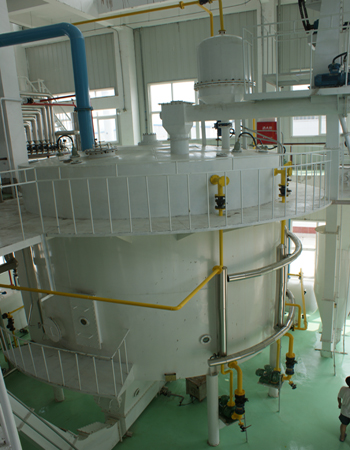The working principle of the leaching equipment is to use organic solvents to fully contact the oils, leaching the grease in the oils to form a mixed oil, and then use the different boiling points of the solvent and the grease to evaporate and separate the solvent to obtain crude oil. The leaching equipment is favored by oil plants for its advantages of low processing cost, high oil yield, and high labor efficiency. It is a kind of oil extraction equipment commonly used in oil plants. However, in the process of oil leaching, various factors will affect the leaching efficiency. Next, Henan Zhongxing Grain and Oil Machinery will introduce several factors that will affect the leaching efficiency of the leaching equipment.

1. The influence of the structure and properties of the blank
The degree of broken oilseeds, the firmness of the preforms and the amount of shells in the raw materials all have an impact on the efficiency. The powdery, porous and strong extruded material is better than the rolled billet; a certain amount of shell content is more conducive to solvent penetration; the more thorough the destruction of oilseed cells, the more conducive to the diffusion of solvents and grease, which can improve the leaching efficiency.
2. the influence of billet moisture
In addition to alcohols, general solvents can only dissolve oils and fats but do not dissolve in water. Therefore, when the water content is high, the solvents will not easily penetrate into the cells to dissolve the oils. Therefore, proper moisture is also very important.
3. the influence of blank temperature
Higher billet temperature lowers the viscosity of grease, improves fluidity, and improves leaching efficiency.
4. The influence of leaching production process conditions
Process conditions mainly refer to the leaching temperature and time, the thickness of the material layer, the penetration rate of the solvent (or mixed oil), the amount of solvent (material-dissolving ratio or solvent ratio), and draining time.
The leaching temperature should be consistent with the temperature of the blank. The longer the leaching time and the more leaching stages, the lower the residual oil rate in the meal.
Billet layer thickness In the case of higher billet structure strength and low powder content, the higher the material layer, the higher the utilization rate of the equipment without affecting the leaching efficiency.
Accelerating the penetration rate in the leaching process means increasing the amount of solvent sprayed per unit time, which is very important to the oil extraction efficiency of the leaching process and can greatly improve the processing capacity of the equipment.
The size of the solvent ratio directly affects the technical indicators of the mixed oil concentration, leaching rate and residual oil rate after leaching.
Draining time and soluble content of wet meal The more residual solvent in the wet meal after leaching, the greater the energy required to recover the solvent and the increase in residual oil.
In summary, the factors that affect the leaching effect often need to be considered at the same time in actual production. However, attention should be paid to distinguishing the primary and secondary and comprehensive application for different oil materials and different technical requirements to achieve the main purpose of improving the leaching effect.
Copyright © Henan Zhongxing Grain And Oil Machinery Co.,Ltd. All Rights Reserved. Powered by MetInfo